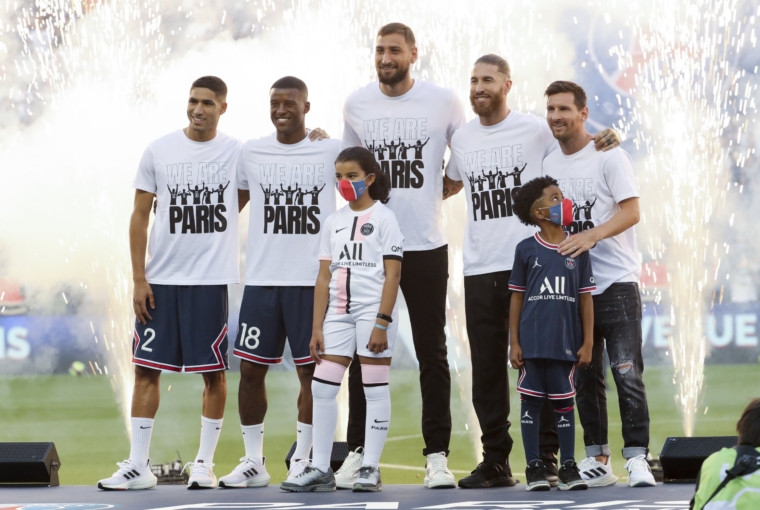Prepare yourselves for a bunfight. The long list of players whose contracts expire next summer includes all of the top seven in last year’s Ballon D’Or voting – Lionel Messi, Robert Lewandowski, Jorginho, Karim Benzema, N’Golo Kante, Cristiano Ronaldo and Mo Salah. You can add in Kylian Mbappe and Paul Pogba for this summer, too. Over the next two years, the best players in world football could all change hands without a transfer fee in sight.
This is partly down to the age profile of those players considered to be the world’s best. Perhaps the majesty of the Messi and Ronaldo era has subconsciously persuaded us to appreciate ageing players more, or perhaps the rise in conditioning has simply prolonged the careers of the world’s elite, but only one of that top seven is yet to turn 30; Salah’s 30th birthday is on June 15. But it doesn’t make it any less extraordinary that the best of the best will all hit the free market within 12 months of each other.
That is no coincidence. The mismanagement of several of Europe’s biggest clubs has coincided with a global pandemic that has forced comparative austerity. While Premier League clubs have the insurance of their broadcasting deal, others do not have that luxury and transfer budgets have been slashed. We have perfect laboratory conditions for Bosman deals.
Focusing their recruitment on out-of-contract players allows them to reduce upfront costs and offer attractive salary packages and players evidently understand their opportunity. It gives any superstar greater leverage with their current clubs – “You’ll lose me on a free so you better pay what I think I’m worth” – but also with potential suitors – “You’re getting me for free and you will face competition so you better pay what I think I’m worth”. Without any transfer fees, players can also push for bumper signing-on fees.
More from Football
And their agents will do the same. With Fifa intent on implementing – and fighting any legal challenge against – the introduction of a cap on their splits (10 per cent of transfer-related payments and three per cent of wages), super agents will be more intent than ever to maximise their clients’ earning potential.
The notion of a free transfer is obviously a fallacy. Aaron Ramsey reportedly signed a four-year deal worth £325,000 a week at Juventus in February 2019 ahead of his contract expiry that summer. There was no transfer fee, but those figures equate to £67m over the course of the contract. If the lack of transfer fee pushes wages and signing-on fees higher, deals don’t necessarily get any cheaper.
“It’s been clear for some time that top players hold the upper hand, as clubs are acutely aware of the risk of losing them for nothing if they run their contracts down,” says football finance expert and author of the excellent Swiss Ramble Twitter account Kieron O’Connor. “You only have to look at last summer when PSG, who are not exactly short of money, bought no fewer than four quality players on free transfers.
“But there’s no such thing as a free lunch or indeed a “free” transfer, as the purchasing club will have to commit to high wages (probably higher than otherwise if there is no transfer fee), pay a tasty signing-on fee for the player and hefty agent’s fees. The extent of that financial commitment might still make clubs think twice even if a player is available for nothing. Plus how many clubs can genuinely afford such players?”

And so you have a limited market, in which the same select few clubs are competing for an increasing number of out-of-contract megastars who often leave one of these elite clubs for another. Last summer, Paris Saint-Germain signed Messi, Georginio Wijnaldum, Sergio Ramos and Gianluigi Donnarumma, after they had left Barcelona, Liverpool, Real Madrid and Milan respectively.
Reports suggest that Real Madrid will move for Mbappe, Pogba and Antonio Rudiger next summer. Being known as ‘Free Transfer FC’ would historically have been an accusation of miserliness; no longer.
Whether this is a temporary development or a more permanent shift is open to debate. There has evidently been a dip in the transfer market, at least in terms of transfer fees. O’Connor points out that the Premier League’s net spend on fees in the last transfer window (£560 million) was more than five times the spend of Europe’s other top five leagues combined. But with the end of the pandemic potentially in sight – and with crowds back in full – revenue streams return and so may transfer budgets. With Real Madrid, Bayern Munich and Manchester City making small profits last year, money is still there to fund the mega buys.
“In any case, football clubs increasingly use debt to fund transfers, both by taking out bank loans, which is how Barcelona managed to buy Ferran Torres recently, and also by only paying transfer fees over a number of years, instead of everything upfront,” says O’Connor. “Even the wealthy Premier League saw transfer debt more than quadruple in the five years up to 2020 from £600 million to £2.6 billion.”
Perhaps then, this will come down to whether players prefer longer contracts that guarantee themselves continued income if things sour or back themselves to maintain high performance, create a position of dominance in negotiations and seek out moves to another elite club. For the next 18 months at least, they appear to have chosen the latter option. The best of the best hold all the power at their feet.


Potter inherited a mess at West Ham - his bold call has already given fans hope